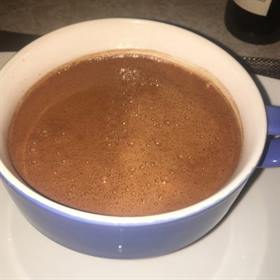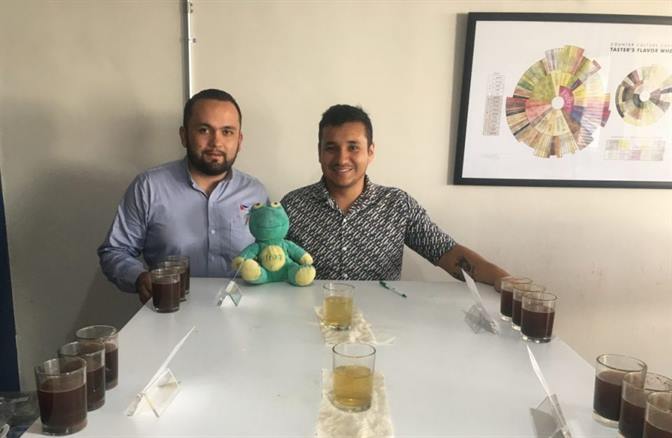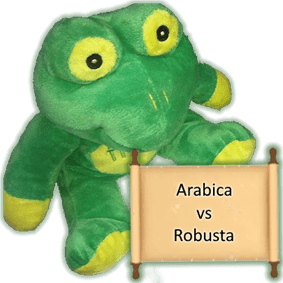After visiting the two farms in Oaxaca state, we ended up in Oaxaca City or Oaxaca de Juárez. We arrived late in the evening and were staying outside the city. As we were leaving early the next morning, I did not pop into the city Zócalo.
I did try an Oaxaca speciality which is a chocolate and beer-based drink, which name escapes me. It is served hot and has a malty and chocolate taste, quite enjoyable.

Oaxaca to Puebla – Edy’s perspective
At just before 6 am we left Oaxaca to head to Puebla before Edy himself went to Chiapas. The trip was around 330kms and took us a smidgen over 4 hours, most of the way the road were very good, incomparison to the previous day.
On the way with my small amount of Spanish knowledge and Edy’s small amount of English, I was able to find out about Edy. He is married with one child who was either one or going to turn one (uno anos). We then started talking about his job.
Edy has been an agronomist for over 15 years, specializing in coffee. In the last 6 months, he has travelled 50,000 km meeting and working with farmers in Oaxaca, Veracruz and Chiapas (where he lives).
Perspectives from Edy on Mexican Coffee Production
Quantity of Chiapas and Vera Cruz production are similar. Oaxaca is lower but has more cultivars (a cultivar is any variety that we harvest and cultivate). Almost all of the production of coffee in Mexico is Arabica.
In Chiapas the highest they grow is 2200 masl, since then it gets too cold. Average bags per farmer in Chiapas is 20 bags, Veracruz around 25 bags. A typical Chiapas farm has 2000 trees per hectare, Vera Cruz has 4000 trees. While in Oaxaca only 1,500 trees per hectare. In Oaxaca a farmer produces only 1.5 bags per farm. They are working on trying to increase the yield per farm in all areas. Chiapas and Veracruz, the average farm is 2 acres. In Oaxaca only 1 acre.
The number of agronomists specialising in coffee is relatively small. Cash crops like maize are more popular (almost everything in Mexico is made out of maize / corn). He does not work only for Caravela, he is independent and does work with other coffee businesses, or direct with some farmers.
As already stated, Edy does a lot of visits, visiting most of the people they work with around once a month. In 6 months he has travelled over 50,000 kms doing visits.
Mexican harvest is typically Nov-Feb, with Geisha April. Geisha is a low production coffee, but it works out since they are paid more of the coffee.
As far as quality cultivars are concerned, in Veracruz about 80% of the cultivars are quality focused, Chiapas 60%, while Oaxaca in around 90% capable of producing specialty.
Over the last 15 years, Edy has seen big changes in the production each year driven by seasonal plant nutrition and weather. Roya (coffee rust) has dramatically affected production with the farmers being hit hard. With Roya farms in Chiapas produced only an average of 5 bags (25% of before). So the rust has a big impact on production. Through experimentation, they have found that above 1800masl no Roya or Broca. Broca occurs with coffees around 1200 masl.
They are teaching the farmers to spray with copper to prevent Roya now. Typically 30 days before the blossoms are expected.
Puebla Afternoon
After Edy dropped me off, I took some time to settle into my hotel before trying to figure out what to do with the rest of my day. José Antonio was going to call me, but I found out later he was down with a stomach bug.
So after taking a break, I looked up the free walking tour I had done in Mexico City, and found there was one at 15:00 from the Zócalo in Puebla (the short name for Pueblade los Ángeles).
My hotel was the first I stayed in since Mexico City that had decent WiFi and hot water, so I felt rather spoilt. With the hotel about 10km from the square, Frida had told me to use Uber, so I did. Twenty minutes later an Uber dropped me about 2 minutes walk from the Zócalo. Which I walked to, and saw a bustling square with a cathedral on the right as I came in. The rest of the square is surrounded by restaurants and mini vendors. In the square, I found live music, balloon and trinket sellers.
I walked around a bit then joined the free walking tour of Puebla. The city is very neat and pretty, much better laid out than Mexico City with larger pavements, making walking a lot easier. During the tour, we saw the Cathedral, the Library (the first in America called Biblioteca Palafoxiana), the old map made out on Puebla ceramic tiles. These tiles are made a specific way in Puebla (a combination of local, western, and eastern methods). We also went past the La Pasita (the most famous bar in Puebla), where I returned after to try their speciality a shot of some alcohol with goats cheese and a raisin, it was an interesting flavour combination. It was a little rushed as they were closing.
We also went across what used to be the river – which is now a main road. They moved the river underground and put a street on top. You can still see the old bridge. We went past a public dancing place, which the locals go to on Sundays to meet and dance with each other. Carmina the guide told me that this is what the Mexicans do they like to fiesta.
Afterward, we went down the Barrio del Artista, a section that artists are given to exhibit their work and sell to the public. Small little work areas and galleries next to one another. The locals go there to buy crafts and paintings. We then went up the street of candy or sweets and tried Myega a favourite with the locals. From there we went to the Templo de Santo Domingo, famous for its gold decor.
I put to get a video of the sites and sounds of Puebla.
Puebla Video
Caravela Visit
Perspectives from José Antonio
A general cupping of Mexican coffees

Mexico and Origin Travelling
Sincerely Warren



